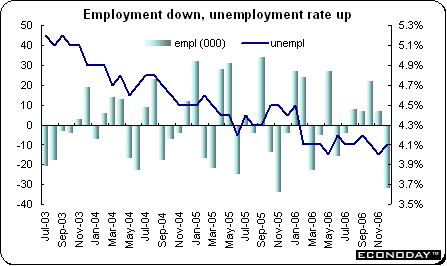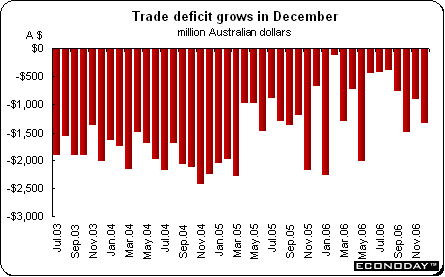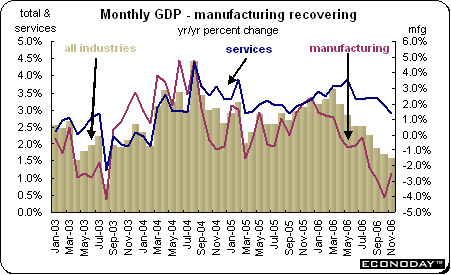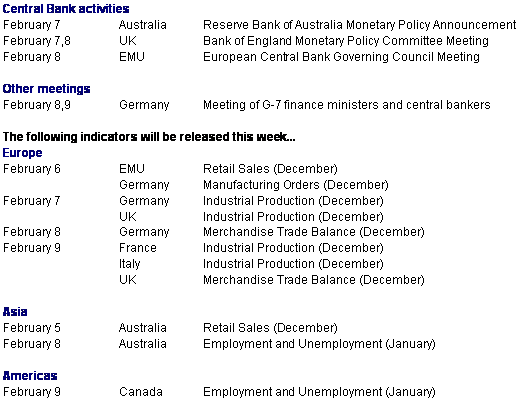Global stocks were boosted mid-week after the Federal Reserve offered some soothing words in their post-FOMC meeting statement. The Bank showed a growing confidence that the economy is heading for a soft landing. The statement implied that the U.S. housing market that has had market participants fretting, could be bottoming out. At the same time the FOMC commented on its inflation-fighting progress. Until recently, investors had been convinced the Fed would reduce the funds rate from its current 5.25 percent level despite little indication from the Fed itself that this would happen. Now baring any unforeseen event, this scenario looks less and less likely. Equities that were still trading (North America) soared on the benign FOMC statement. The graph below shows major central bank policy rates at the end of January 2007. February's round of meetings begins this week with the Reserve Bank of Australia, Bank of England and the European Central Bank holding policy meetings.

When a FOMC meeting is scheduled, markets tend to go into 'vigil' mode and little happens until the meeting's results are known. The Fed move had less of an impact on the U.S. dollar than on equities. For the dollar, a deluge of mediocre economic data combined with a steady stream of rhetoric in the run up to the Group of Seven finance and central bank leaders meeting on February 9 and 10 absorbed currency trader interest. But at week's end, comments concerning the yen's weakness faded and the yen continued to lose strength.
For the record, all indexes tracked here with the exception of the Kospi (down 5.2 percent) and the FTSE (down 0.3 percent) were up in January. All indexes gained last week. Only the Kospi remains below its year-end level. The Dow Industrial Average soared to yet another record high after the FOMC left interest rates unchanged and offered the markets some badly needed reassurance on the U.S. economy. In contrast to the robust performance of Asian and European stocks on Friday, North American indexes drifted.
Global Stock Market Recap

Europe and the UK
Pre- and post-FOMC equity trading are very apparent in the graph below. Equity markets in Europe and the UK were already closed on Wednesday when the Fed announced its policy decision. However, all three indexes followed here made up for their tremulous start to the week on Thursday and Friday.

The CAC and DAX drove to new six-year highs by week's end as merger activity picked up especially for retailers and utilities. European equity investors were cheered on Friday by the U.S. employment report which showed that the economy created less jobs than expected in January, reinforcing hopes that interest rates would not go higher. On Thursday, European equities benefited from the worldwide equity rally. Financials and pharmaceuticals were the main drivers of the increases.
The FTSE also climbed to its highest level in six years on Friday. The FTSE was fueled by a surge in J. Sainsbury Plc shares when a trio of private equity firms said they were considering an offer for the supermarket chain. Friday's gains built on Thursday's positive trading. Not a single constituent closed in negative territory Thursday as the London market enjoyed one of its strongest sessions so far this year. The index was boosted by strong results from Royal Dutch Shell. Traders said they could not remember the last time the FTSE 100 had enjoyed such widespread gains.
Asia/Pacific
Asian/Pacific stocks more than offset lackluster trading early in the week with robust gains in the post-Fed environment on Thursday and Friday. Many hit nine-month highs thanks to positive earnings reports along with favorable news on U.S. consumer spending. Stocks such as Sony and Samsung Electronics led exporters' gains. The Kospi, after sinking by 5.2 percent in January recovered all but 1.5 percent in post-Fed trading in the first two days of February. Indexes in Australia and Singapore climbed to all-time highs as reassuring comments from the Fed on growth and inflation enthused investors.

In Japan, stocks were boosted by favorable earnings reports from a wide variety of companies including pharmaceuticals maker Dai-Ichi Sankyo and mobile operator NTT DoCoMo. On the negative side, semiconductor firm Fujitsu led this sector lower. The company blamed sharp drops in the prices of microchips and hard drives for a drop in quarterly profits.
Canada
Canadian stocks were boosted by climbing oil and bullion prices and hit an all-time high on Friday. In December 2006, the S&P/TSX Composite ventured over the 13,000 level for the first time but quickly fell back as energy and mineral prices declined. But with icy temperatures in the U.S., energy prices began to climb again and energized those companies in the supply chain. Energy shares have nearly tripled since the market hit a low in October 2002, and are the second-best performers among the index's 10 industry groups second only to computer stocks.

Currencies
The yen was under verbal attack last week as European politicians threatened to discuss the weak Japanese currency at the upcoming Group of Seven meeting in Essen, Germany on Friday and Saturday. For the past six months, European finance ministers have complained about the yen's decline to a record low against the euro. They are concerned it will hobble exports from Europe just as the economy is beginning to grow. The yen has dropped about 5.6 percent against the euro in the past six months. It reached a record 158.62 on January 24, just six days after the Bank of Japan kept its key interest rate at 0.25 percent, the world's lowest interest rate. The yen has also dropped about 4.3 percent against the U.S. dollar during the same time span. At week's end most of the brouhaha surrounding the yen's weakness faded as prospects of the currency being an agenda item for G7 diminished. On the week, the yen was slightly higher against both the dollar and euro.

When the yen hit a four-year low against the U.S. dollar last week, it intensified fears that the higher volume of currency-based carry trades could jolt markets if these positions were suddenly unwound. A carry trade involves borrowing in currencies with low interest rates, such as the yen and the Swiss franc, to invest in those that pay higher rates, such as the Australian dollar. According to Barclays Capital, speculative carry trades have reached their highest level since the Russian crisis in 1998. It is impossible to measure precisely the size of carry trade transactions because they can involve several currencies.
Indicator scoreboard
EMU - December unemployment rate edged down to 7.5 percent from 7.6 percent in November. Unemployment declined in Germany, France, Finland, Belgium, and the Netherlands. The steady decline from December 2005 when the unemployment rate was 8.4 percent has been the result of improving economic conditions in the major EMU Member States.

January flash harmonized index of consumer prices was up 1.9 percent when compared with a year ago. This is the first release that includes Slovenia, the newest member of the EMU. The HICP has been under the ECB's inflation ceiling of 2 percent for five months. As with all flash reports, no detail is available.

EU - January economic sentiment index edged down to 109.2 from 109.8 in December. With the January release, the data now include the newest member to the EMU, Slovenia. The data for the entire EU also now include Rumania and Bulgaria. Industrial confidence declined to 5 from 6 in the previous month thanks to lower orders and higher stocks. Consumer sentiment declined to minus 7 from minus 6 on worries for the general economic outlook. Retail and construction sentiment also declined. However, services sentiment increased to 20 from 19.

Germany - December retail sales excluding autos and gasoline stations were up 2.4 percent but were down 0.2 percent when compared with last year. Total retail sales soared 4.4 percent and 6.1 percent on the year. Consumers bought in December to avoid the 3 percent increase in the value added tax (VAT) that went into effect with the New Year.

January unemployment rate dropped to 9.5 percent from 11.4 percent a year ago. The unemployment rate in the east dropped to 15.8 percent from 18 percent just a year ago, while in the west, the unemployment rate sank to 7.9 percent from 9.7 percent a year ago. December International Labour Organisation unemployment declined by 40,000 while December employment was up by 41,000. The ILO unemployment rate declined to 7.6 percent, significantly below the 9 percent rate of a year ago. The ILO defines unemployed persons as those without work who are actively looking for a job and could start work immediately. ILO unemployment data are lagged by one month because of the sampling technique used.

France - December unemployment rate edged down to 8.6 percent from 8.7 percent in the previous month. The number of jobless declined by 22,000 according to the International Labour Organisation definition which excludes jobseekers who did any work during the month. The unemployment rate is at its lowest since 2001.

December producer price index edged down 0.1 percent and was up 2.4 percent when compared with last year. Core PPI which excludes food and energy was up 0.1 percent and 2.8 percent on the year.

Asia
Japan - December retail sales declined 0.2 percent and were down 0.3 percent when compared with last year. Large retailers and department stores led the decline. It should be noted that the report could underestimate consumption because it does not reflect services and Internet spending. Retail sales declined in all major categories except food and beverages.

December spending by Japanese households headed by wage earners dropped 3 percent when compared with the previous year. Wage-earner household spending is an important gauge of personal consumption, which accounts for roughly 55 percent of gross domestic product. The propensity for wage earners to consume, a ratio that measures the amount of disposable income that went into household spending, dropped to 44.5 percent.

December unemployment rate edged up to 4.1 percent as employment declined by 32,000 jobs. The job-to-applicant ratio, which shows how many jobs are on offer to a job seeker, rose to 1.08 in December, partly as the total number of people offering themselves for work declined. The demand for workers exceeded the supply of applicants every month last year.

December industrial production climbed 0.7 percent and 4.4 percent when compared with last year. Growth was fueled by higher overseas demand for automobiles and machinery. The surge in demand from automakers is also benefiting steel makers, who are also stepping up production to meet demand from Toyota and overseas.

Australia - December merchandise trade deficit widened to A$1.34 billion from A$897 million in November. Aircraft imports were up while wheat exports sank. Exports were down 0.7 percent while imports climbed by 1.7 percent. Australia's worst drought in a century has cut shipments from the world's third-largest wheat exporter. Imports of capital goods including business machinery, aircraft & vehicles, climbed 6 percent. Farm exports, such as meat, sugar, wheat and wool, declined 4 percent, led by a 9 percent drop in grain exports. Shipments of non-rural goods, which include minerals, decreased 0.4 percent. Services exports rose 1 percent.

Americas
Canada - November monthly gross domestic product was up 0.2 percent and 1.6 percent when compared with last year. Both manufacturing and services were up 1.6 percent and 0.2 percent respectively. Eleven of 21 major manufacturing groups were up, accounting for 67 percent of total manufacturing value added. However, the energy sector declined 2.5 percent with extraction down 2.9 percent and exploration down 3.7 percent.

December industrial product price index jumped 1.4 percent and up 3.6 percent when compared with last year. The reason for the monthly jump was the significant price increases for petroleum and coal products, primary metal products and motor vehicles. The upward pressure on the annual increase came mainly from higher prices for primary metal products, pulp and paper products as well as fruit, vegetables and feed products.

December raw materials price index soared by 5.2 percent and was up 11.7 percent when compared with last year. The monthly increase was due to higher costs for mineral fuels, non-ferrous metals, animals & animal products and vegetable products.
The value of the Canadian dollar against the U.S. dollar was down 1.5 percent in December. As a result, the total IPPI excluding the effect of the exchange rate would have increased 1 percent instead of 1.4 percent. On a 12-month basis, the value of the Canadian dollar rose 0.7 percent against the U.S. dollar. If the impact of the exchange rate had been excluded, producer prices would have risen 3.8 percent between December 2005 and December 2006, rather than their actual increase of 3.6 percent.
Bottom line
Last week provided a slew of new data to keep analysts busy. And if that were not enough, the U.S. Federal Open Market Committee (FOMC) held a two-day policy meeting. Statement parsing ensued as each analyst sought to put a spin on it. In the end, equities especially were pleased with the Fed's benign economic outlook while others in bonds and currencies were still looking for signs that interest rates might change.
This week provides the usual first-week-of-the-month onslaught of monthly central bank meetings. The Reserve Bank of Australia will issue its announcement Wednesday morning local time (5:30 PM ET Tuesday night on the U.S. east coast). No policy change is expected. The RBA has an inflation target of 2 to 3 percent. After two quarters of CPI gains hovering at 4 percent, the CPI declined in the fourth quarter to an increase of 3.2 percent on the year. The RBA is expected to leave interest rates unchanged at 6.25 percent.
The Bank of England, after shocking the markets with a surprise preemptive increase to 5.25 percent in January, is expected to leave rates unchanged on Thursday. December's CPI was up 3 percent on the year, one full percentage point above the Bank's inflation target of 2 percent.
The European Central Bank is also expected to maintain its 3.5 percent policy interest rate. Flash harmonized consumer prices have now receded to just under the Bank's inflation ceiling (not higher than 2 percent) to 1.9 percent on the year even though the ECB's other 'pillar' of monetary policy, M3 money supply growth, is more than double the Bank's target of 4.5 percent. M3 grew at an annual rate of 9.7 percent in December, fastest rate since the launch of the euro in 1999. Analysts are expecting an increase in either March or April, and perhaps another in June.
At week's end the Group of Seven financial ministers, representing the U.S., Japan, Germany, U.K., France, Italy and Canada, will meet in Essen, Germany on February 9 and 10. It will be their first meeting since a September meeting in Singapore, where the group reaffirmed its preference for market-based exchange rates.
Looking Ahead: February 5 through February 9, 2007

Anne D Picker is the author of International Indicators and Central Banks.

